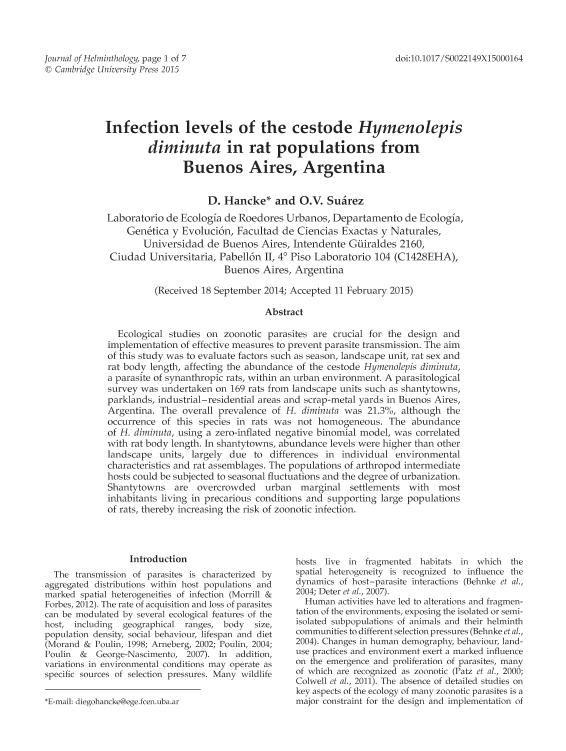Artículo
Infection levels of the cestode Hymenolepis diminuta in rat populations from Buenos Aires, Argentina
Fecha de publicación:
03/2016
Editorial:
Cambridge University Press
Revista:
Journal of Helminthology
ISSN:
0022-149X
Idioma:
Inglés
Tipo de recurso:
Artículo publicado
Clasificación temática:
Resumen
Ecological studies on zoonotic parasites are crucial for the design and implementation of effective measures to prevent parasite transmission. The aim of this study was to evaluate factors such as season, landscape unit, rat sex and rat body length, affecting the abundance of the cestode Hymenolepis diminuta, a parasite of synanthropic rats, within an urban environment. A parasitological survey was undertaken on 169 rats from landscape units such as shantytowns, parklands, industrial-residential areas and scrap-metal yards in Buenos Aires, Argentina. The overall prevalence of H. diminuta was 21.3%, although the occurrence of this species in rats was not homogeneous. The abundance of H. diminuta, using a zero-inflated negative binomial model, was correlated with rat body length. In shantytowns, abundance levels were higher than other landscape units, largely due to differences in individual environmental characteristics and rat assemblages. The populations of arthropod intermediate hosts could be subjected to seasonal fluctuations and the degree of urbanization. Shantytowns are overcrowded urban marginal settlements with most inhabitants living in precarious conditions and supporting large populations of rats, thereby increasing the risk of zoonotic infection.
Palabras clave:
Hymenolepis diminuta
,
Rats
,
Urbanization
,
Zoonotic diseases
Archivos asociados
Licencia
Identificadores
Colecciones
Articulos(IEGEBA)
Articulos de INSTITUTO DE ECOLOGIA, GENETICA Y EVOLUCION DE BS. AS
Articulos de INSTITUTO DE ECOLOGIA, GENETICA Y EVOLUCION DE BS. AS
Citación
Hancke, Diego; Suarez, Olga Virginia; Infection levels of the cestode Hymenolepis diminuta in rat populations from Buenos Aires, Argentina; Cambridge University Press; Journal of Helminthology; 90; 2; 3-2016; 199-205
Compartir
Altmétricas




